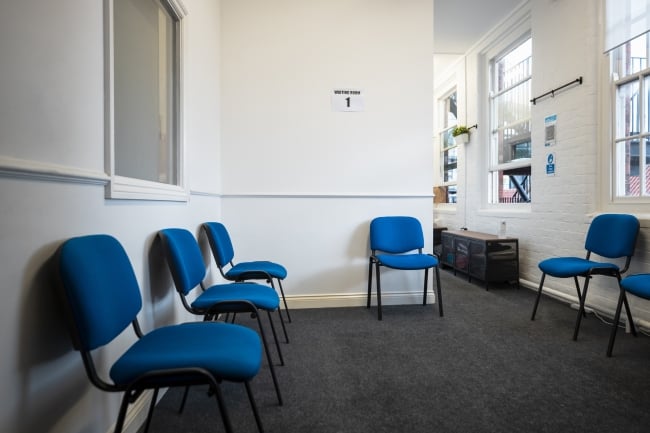You have /5 articles left.
Sign up for a free account or log in.

College students can be nervous to engage with their counseling center. Transforming spaces on campus to make health and wellness more comfortable and inviting can destigmatize services and encourage help-seeking behaviors.
SolStock/E+/Getty Images
As student mental health concerns continue to rise, encouraging students to utilize campus resources or become aware of wellness programs is critical to their retention and success.
A spring 2023 Student Voice survey by Inside Higher Ed and College Pulse found one-third of students do not know or are unsure of where they can seek help on campus if they or a friend are experiencing a mental health crisis.
One way colleges and university leaders can encourage students to consider mental health services is by making their physical spaces more inviting and accessible to learners, Renae Mantooth, research lead in education at HKS Architects shared at The State of Equity in America event, presented by U.S. News & World Report on June 5 in Washington, D.C.
“It’s not just understanding what is excluding, what is othering, but how do we celebrate and create those warm, safe environments on campus too,” Mantooth said.
During the panel on mental health and neurodiversity on college campuses, Mantooth gave the example of an HKS client in Florida that has an informal environment in the student health center that allows students to charge their phones or study in between classes, creating a safe space for learners to engage with practitioners.
Inside Higher Ed compiled four examples of campuses that are modifying or opening their counseling or health centers to meet students’ wellness needs through an inclusive space.
California State University, Bakersfield
In March, CSUB opened its new, expanded student counseling center on campus. Previously, the counseling center was housed within the student health center, but students said the environment was too clinical, as reported by youth media organization Kern Sol News.
Now, the waiting area has free refreshments and a TV that students can watch while they wait, as well as large rooms to support group activities and social events.
Staff said they hope that the new space encourages students to destress, normalizes counseling and reaches students who may hold misconceptions about how they can benefit from mental wellness activities.
University of Kentucky
In 2022, UK opened a new student wellness space in the College of Agriculture, Food and Environment’s Agricultural Science Center, renovating an old computer lab to accommodate students who want to destress. Campus leaders wanted to provide additional space for students to prioritize their mental health without having to cross campus to access services.
The space comes with soft furniture, ambient lighting, mindfulness activities, a wall to write motivational messages for peers, self-care literature and a station to mail a stamped card with a message of gratitude.
The room is also used by UK Counseling Center’s team to host weekly drop-in counseling sessions and wellness events.
Another Way of Reaching Students
The inverse of making facilities student friendly is moving services to where students already visit.
Embedded counselors in different spaces or student groups can help build trust with students and guide them to care in a more formal setting. Informal, drop-in counseling sessions like the Let’s Talk Cornell model can also reach students around campus and get them more familiar with what counseling or therapy could look like.
Do you have a wellness tip that might help others encourage student success? Tell us about it.
Stony Brook University
In spring 2023, Stony Brook University in New York completed renovations to its Student Health Services and Counseling Center building, which included remodeling the lobby area.
Now, the health center space has a fireplace and all-gender restroom to make visitors more comfortable, plus a new seating area for students to relax in. All spaces are now physically accessible for visitors with disabilities, as well.
Virginia Polytechnic Institute and State University
Virginia Tech’s Cook Counseling Center opened a serenity space on campus in fall 2023, which services students as a self-care resource room during the day, in addition to the facility’s meditation, prayer and creative expression spaces.
The room was initially designed to give students a transitional phase from when they leave their counseling session but before they go back into their usual routines, according to a university release. It was later modeled to allow any student access for rest and relaxation, regardless of if they were attending a therapy session.
Inside, the room has yoga supplies, relaxation chairs and biofeedback equipment to regulate breathing and heart rate, as well as a water wall for a peaceful environment.
The Cook Counseling Center also has multiple waiting rooms, making it more accommodating for students as they seek care.




